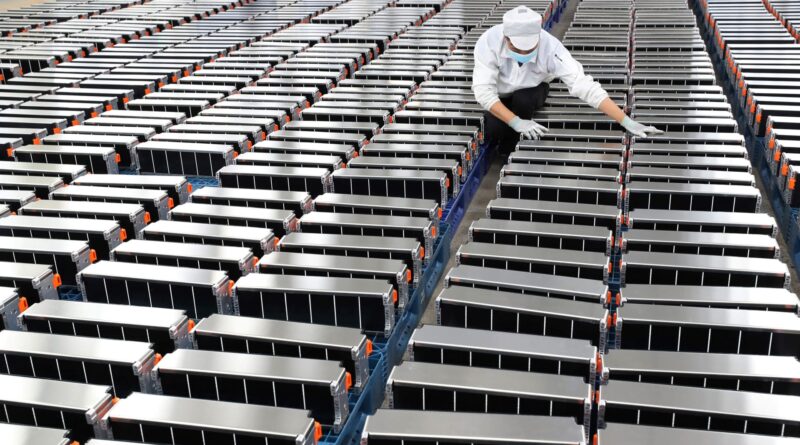The race for next-gen EV batteries could quickly pivot to semi-solid-state
Automotive batteries at a manufacturing facility in Nanjing in China’s japanese Jiangsu province.
Str | Afp | Getty Photos
PARIS, France — The push to commercialize solid-state batteries for electrical autos (EVs) is nicely underway, however analysts say auto giants may very well be on the cusp of turning to a unique sort of transformative science.
Strong-state batteries have lengthy been billed because the “holy grail” of sustainable driving. Because the title suggests, solid-state batteries include a stable electrolyte, constituted of supplies equivalent to ceramics. That makes them completely different from standard lithium-ion batteries, which include liquid electrolyte.
This next-generation expertise theoretically packs extra power into every unit of quantity than lithium-ion batteries. Proponents say it provides safer, cheaper and extra highly effective batteries for electrical autos (EVs), in addition to quicker charging occasions.
Automakers have invested billions of {dollars} in solid-state battery analysis and teamed up with builders to supply their very own variations for mass manufacturing.
An indication is displayed exterior a Toyota Motor Corp. dealership on Jan. 30, 2024 in Tokyo, Japan.
Tomohiro Ohsumi | Getty Photos Information | Getty Photos
Japan’s Toyota, for example, has said it’s aiming to deliver solid-state batteries into mass manufacturing between 2027 and 2028. The automaker stated a latest breakthrough in its bid to enhance the sturdiness of its expertise means the battery is anticipated to supply a spread of 1,000 kilometers (621 miles) and a charging time of simply 10 minutes.
Japan’s Nissan said in April that it plans to launch solid-state batteries for EVs by early 2029, whereas Germany’s Mercedes-Benz Group and U.S. battery startup Factorial said in September that they’re working collectively on a solid-state battery that shall be prepared for manufacturing by the tip of the last decade. Factorial additionally has joint improvement agreements with automakers together with Stellantis, Hyundai and Kia.
The typical vary for EVs within the U.S. is sort of 300 miles (or 483 kilometers) on a single cost, in response to the Environmental Protection Fund, whereas the time it takes to cost a battery-powered EV can take 20 minutes or a number of hours, relying on the automotive and the pace of the charging level.
Max Reid, an analyst at Wooden Mackenzie, stated solid-state batteries are at the beginning of an extended journey towards commercialization.
“Clearly, the outcomes are trying very promising — a lot safer, a lot better power density and significantly the charging speeds, which we predict might be one of many foremost advantages of solid-state,” Reid advised CNBC by way of video name.
But, regardless of rising hype over the potential rollout of solid-state batteries, analysts stay skeptical about when they are going to really make it to market.
Semi-solid-state batteries
One main downside with solid-state batteries, Wooden Mackenzie’s Reid stated, is the swelling of the battery throughout charging and, finally, the degradation of the cell after intensive recharging.
“5 years in the past, if we talked about this, I might have been so enthusiastic about solid-state batteries,” Julia Poliscanova, senior director for autos and e-mobility provide chains on the marketing campaign group Transport & Setting, advised CNBC on the Paris Motor Present.
“However someway inside this area between pilots and commercialization, there’s some sort of barrier at this time, some sort of blockage as a result of each time I communicate with automotive executives at battery conferences, I preserve listening to the identical reply: ‘We’re 5 to seven years away.'”
“While you have a look at the present expertise, the lithium-ion batteries, they’ve simply been enhancing a lot. The incremental enchancment of a less expensive expertise has been so good that perhaps it isn’t so engaging anymore to place all that spotlight on solid-state,” Poliscanova added.
There may very well be another choice, nonetheless: semi-solid-state batteries. These cells use a hybrid design of stable electrolyte and liquid electrolyte — and a few analysts say they may function a bridge between the 2 forms of batteries.
Guests have a look at the sales space of Catl on the 2023 Shanghai Auto Present in China.
Cfoto | Future Publishing | Getty Photos
Semi-solid batteries have already been commercialized “to fairly a very good extent” in China, Reid stated, “and truly, my opinion is that, that is the compromise expertise that truly will eliminate the necessity of a full solid-state.”
“Given slower [EV] demand in the West and these points with solid-state, you would possibly see some unfavorable bulletins or not-so-positive bulletins for full solid-state and truly a little bit of a pivot to semi-solid as soon as that is realized to be a greater transitional expertise for what this decade wants,” Reid stated.
The event of semi-solid-state batteries is primarily being led by Chinese language corporations, together with CATL, one of many world’s largest battery producers, and the likes of WeLion, Qingtao Vitality and Ganfeng Lithium.
Chinese language EV maker Nio has already commercialized 150-kilowatt hour semi-solid-state batteries for its EVs, with a spread of as much as 1,000 kilometers. Individually, Ganfeng LiEnergy, a subsidiary of Ganfeng Lithium, is producing semi-solid-state batteries for EVs with a spread of 530 kilometers.
Lithium-based batteries ‘nonetheless the way in which to go’
Transport & Setting’s Poliscanova stated she is seeing progress on semi-solid-state batteries in China, “as a result of whoever it’s that understands the best way to make batteries will at all times be making the following one.”
“I believe there was much more consideration and commercialization to the decrease price improvements versus solid-state. It have to be as a result of inside the automobile area, the efficiency is already adequate. Sure, we are able to discuss vehicles and planes, however within the automobile area, 600 to 800 kilometers is ok. It is sufficient,” she added.
Not everyone seems to be satisfied of an imminent pivot to semi-solid-batteries — or the hype over the mass rollout of solid-state batteries within the subsequent few years.
“The fact is that for now, once we’re trying on the EV area, lithium-based batteries [are] nonetheless the way in which to go,” Michael Widmer, head of metals analysis at Financial institution of America international analysis, advised CNBC’s “Squawk Field Europe” on Oct. 9.
“That is the mainstay and it’ll in all probability keep like that for the following 5 to 10 years,” he added.





